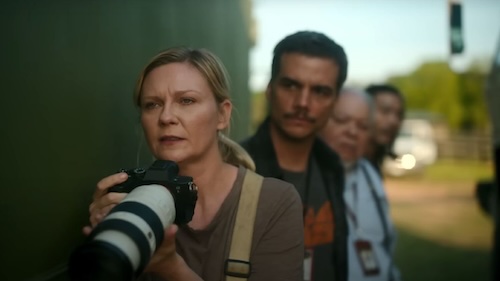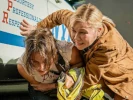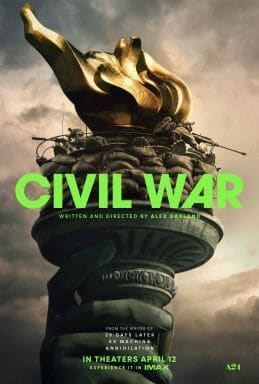Eye For Film >> Movies >> Civil War (2024) Film Review
Civil War
Reviewed by: Andrew Robertson

It's now just over 50 years since Truffaut argued that it was impossible to make an antiwar film. That was in a Chicago Tribune interview with Gene Siskel, whose colleague Roger Ebert described films as "a machine that generates empathy." Truffaut's words were that "Every film about war ends up being pro-war," in a piece published on Armistice Day, November 11th 1973. A Sunday too. I'm quoting from page 228 when physical media was still fat with advertising that now tracks more effectively than any slippered foot across a lawn. That musing was extended by Siskel, who says that "every war film, just like every war, has its heroes, and that, too, seems to cut across any anti-war sentiment."
Is Civil War an anti-war film? I'm perhaps appropriately conflicted about it, and I doubt I'd be alone. If the mark of art is to allow multiple interpretations then I think that Civil War succeeds but I'm still not sure what it's hoping to say. I suddenly find myself reminded of that bumper sticker which spells 'coexist' from religious iconography, symbols become platitudes slapped onto an avatar of destruction. It's not the bullets with your name on them, nor the ones marked 'to whom it may concern', but the breakdown of structures to the point that you no longer have a doorstep to carry what says 'while you were out.'

Kirsten Dunst is hauntingly detached as photojournalist Lee Miller, and the film tells us she shares her name with the model turned photographer who captured some of the first pictures of Dachau after liberation. Dunst's Lee says something to the effect of hoping that if she showed America what war was like it wouldn't happen here. Is that irony? Writer/director Alex Garland's mission statement? When we drop from Rob Hardy's moving images to shots snapped by the characters it's just one moment of perspective among many. There are tricks with focus, sunlight on grass, tilts and shifts and blurring. Hardy has worked with Garland several times before. This is his second film in UK cinemas at the moment, as The Book Of Clarence is one of his too. It's purely coincidence that these both seem unfocused, tonally, at least.
A consistent message that background doesn't matter? There's detail that you can look at and try to make sense of but that's perhaps a trap. I could speculate what the presence of F-22s in the air wing of the Western Forces means, given that the Raptor is operated by some Air National Guards. I could discuss what the presence of armed variants of the Eurocopter/Airbus AS555 (or AS550 or H125M) Fennec means in terms of material support from France or Mexico or Chad. I know what Hawaiian shirts might indicate on one set of fighters armed with something that looks like an AR-15 or M4 and I know what nail polish and temporary hair dye might indicate on some others. I caught a reference to neutral territory like Greenland or Alaska. I found myself speculating as to the names for the Bremer Wall variants and their Hesco foothills around the White House. Is that flagpole a Bangalore torpedo? The New York skyline has always had elements of science fiction and fantasy even without denizens of Skull Island, but the supertalls of Billionaires' Row scrape the sky in a way that looks like they applied 57th street to the z-axis.
Instead faces. Wagner Moura as Joel, keeping the fear and loathing at bay with heroic quantities of chemistry. Stephen McKinley Henderson as Sammy, bringing a different flavour of the wisdom and gravity that's inflected his turns in Dune: Part One and Beau Is Afraid. In scenes often as constrained as the interior of an SUV or a sofa in a hotel or the lees of parked vehicles, his craft as a stage actor gives him a presence that commands. Cailee Spaeny has form as an observer changed by the abyss into which they gaze but it's left as an exercise for the reader to determine what distinguishes Priscilla's relationship with Elvis Presley and Jessie's relationship to the war.
Much like Apocalypse Now, this is a picaresque, a travelogue. An exchange with the sniper team at Wonderland recalls a few of those along the Nung river. The rules of BR Street Car should have been applied here. "Never get out of the boat." It's also, like Coppola and Milius and Storaro's epic, beautiful. In places. I was often reminded of the Robert Capa photograph known as The Falling Soldier, or Loyalist Militiaman at the Moment of Death, Cerro Muriano, September 5, 1936. That's from the use of black and white, moments of active stillness, but also falsity.
A few years after Truffaut said those words to Siskel, doubts began to be raised about the authenticity of that image. Does Civil War wrestle with these questions? It puts its characters in these places and shows us the pictures they are taking, but it has its own misidirections, its own explanations, perhaps even its own rules. An early question about air-strikes is a discussion that possibly explains later elements but made me wonder further at helicopters less willing to use the 3rd dimension than the one I crewed in Megadrive videogame Desert Strike or the ones Godzilla ate in 1999.
The uncanny lack of vehicles on roads is an echo of the emptiness of any number of zombie films, including 28 Days Later. Romero's work is often a meditation on capitalism and the last shot (so to speak) of Night Of The Living Dead ricochets through several scenes in Civil War. Rose-tinted glasses and quicklime as a blessing of whiteness, "we just try to stay out of it," a sense that cohesion matters less than vibes. What develops at the end isn't as obvious as Saltburn but it's borrowing from the same set of reactions, image is all and image abounds. In trying to show us cake and eat it too it has some of The Cabin In The Woods about it but these are monsters we have seen before.
Some of the promotional material has apparently been generated by AI, which seems a staggering disjunct to foregrounding of developer fluid and field processing. Digital technology makes it possible for perhaps a tenth of all the US Army's CH-47 Chinooks to roar across the sky, VFX allows a shot whose tricky perspective recalls Tianamen Square but also left me consulting New York City regulations to try to match lane to track width. I kept looking and seeing gaps. Spaces where I was perhaps being invited to do the work, and I'm not averse, I asked you to do some a few paragraphs ago but you know that I had a conclusion in mind and I hope you followed along.
We start with Nick Offerman's President, and while there are questions of motivation the answer is a simple one. The harder questions to answer are why there is footage from figures like Andy Ngo. He's a creature of the right-wing blogosphere, apparently anti-antifa, but such are the calculuses of these spaces that I hesitate to decide what colour his own shirt is. It might be purple, like Waluigi's.
Another videogame reference and so a chance to talk about the valorisation of film, of print. The old world railing against the new. Conflict abounds, even in a backseat described as a kindergarten and an old folks' home. Intergenerational, ethnic-cleansing, the aggressive neutrality of customer-service platitudes. I can't recall anything that reflected the exonerative case so often used to report on officer-involved shootings and I was looking. A film occured, but what comes out of it?
I'm still not sure. The soundtrack shows a particular vintage and ends with a track by Suicide. The score by frequent collaborators Ben Salisbury and Geoff Barrow (of Portishead, Beak) is arch and distant, flattening affect as if a slider on a mixing desk. Sometimes to nothing, image alone. In data theory we are told that absence of a signal should not be used as a signal. Film criticism has to acknowledge that no telegram might convey something understood as a social truth. Let's argue for a moment that being left conflicted by a film about civil war is apposite. Not taking sides is a privilege, but it's one that carries a cost. Was I changed by observing Civil War? I'm not sure anyone would be.
Reviewed on: 22 Apr 2024



















